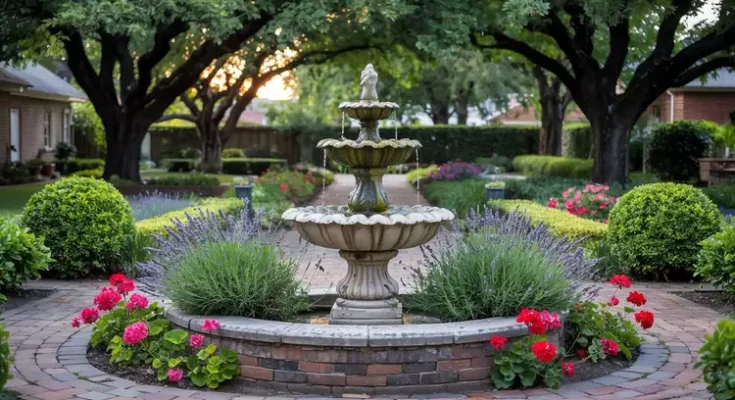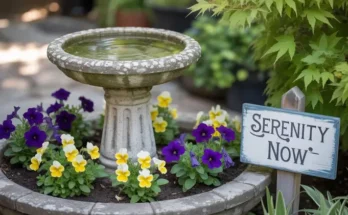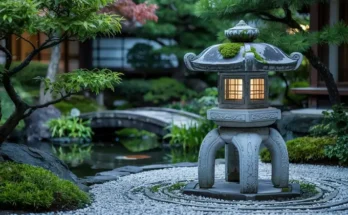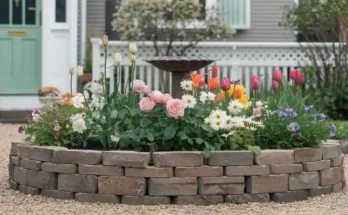Understanding Front Yard Garden Design
The creation of outdoor spaces at the front of houses involves a process that matches building design elements with personal preferences. Strategic planning helps achieve the right combination between space attractiveness and usability.
Front Yard Landscaping Requires These Main Components
Successful front yard design requires three important elements that you should plan carefully.

Walkways and Pathways
The proper arrangement of walkways leads people through your property toward your entrance door, resulting in better accessibility and more elegant decoration. Stone along with brick materials, together with gravel, create lasting beautiful pathways.
Plants and Flowers
A combination of various plants and flowers which offer artistic appeal through multiple seasons must be selected for a beautiful landscape. Mature your landscape with plants from local natural ecosystems since these fulfill both environmental protection goals and require minimum care.
Element | Description | Example |
Lawn Area | A well-maintained lawn to create an open and inviting space. | Well-trimmed grass or a lush green lawn. |
Flower Beds | Colorful flower beds that add vibrancy and beauty. | Tulips, daffodils, and other seasonal flowers. |
Shrubs | Bushes or small trees that provide structure and greenery. | Boxwood, holly, or lavender shrubs. |
Pathways | Paths leading through the front yard to create flow. | Gravel, stone, or brick paths. |
Garden Illumination
Garden illumination through outdoor lighting creates two benefits: it delivers improved security alongside decoration of architectural aspects and garden highlights.
Garden Beds and Pathways
Garden beds, along with pathways, achieve a finished appearance when designed with distinct boundaries created through metal, stone or wood materials.

Lawn Preservation
The preservation of lawn areas leads to a beautiful green environment, which enhances every other garden feature.
Garden Fixtures
Garden fixtures comprised of water elements along with statues and decorative plant storage devices create distinctive points for the eye while adding personality to your landscape.
Popular Front Yard Garden Styles
Our selection of a particular style for front yard gardening helps create a unified aesthetic that harmonizes everything together. Front yard landscaping styles which are frequently chosen include the following main styles:
Modern Minimalist
Many elements of hardscaping combined with minimalistic plants and uncluttered lines define the contemporary minimalist design, thus prioritizing both functionality and simplicity. The gardening practice depends on concrete, steel and gravel materials, together with select architectural plant species.
Element | Description | Example |
Trees | Trees that provide shade and enhance the aesthetics of the yard. | Maple, oak, or flowering cherry trees. |
Water Feature | Water features that create a relaxing sound and visual appeal. | Small fountains, ponds, or birdbaths. |
Lighting | Strategic lighting to highlight key features and improve visibility. | Solar lights, lanterns, or string lights. |
Seating Area | Outdoor seating areas to relax and enjoy the garden. | Benches, swings, or lounge chairs. |
Cottage Garden
The cottage garden design creates a casual appearance with flowers, herbs and shrubs combined in an informal setting. The style presents an open design approach that uses generous plantings to form an attractive, abundant landscape.
Formal Garden
A formal garden demonstrates its characteristics through harmonious shapes in its layout alongside precise hedge cuttings that create an organized design. Traditional design elements consist of topiaries, along with fountains that combine with geometric patterns in garden layouts.
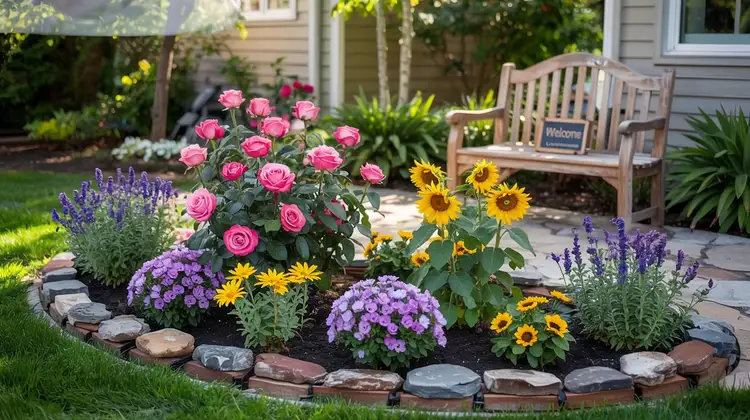
Xeriscape Garden
People living in dry regions should consider xeriscape gardens because they combine drought-tolerant plants with water-efficient landscaping procedures. Aesthetic beauty becomes achievable through this landscaping method, which conserves water resources.
Designing a Functional Front Yard
An outstanding front yard design needs to balance functionality alongside its visual appeal. To have both an attractive and efficient outdoor space, consider these important points:
Assessing Space and Layout
Assess your front yard dimensions together with its form to establish the most suitable arrangement. Your design plans need to factor in the conditions of sunlight accessibility along with the composition of the soil, in addition to accounting for all existing construction in the area.
Creating Focal Points
The garden requires focal points that might include an eye-catching tree, a decorative water element or artwork which will create visual appeal and engagement throughout the space.
Ensuring Privacy
To achieve privacy in your front yard, use natural barriers such as hedges or fences along with skilfully positioned plants that will maintain your welcoming front yard atmosphere.
Enhancing Curb Appeal
Your house exterior will benefit most from plants and materials that choose matching components. The combination of carefully selected colors with a neatly tended outdoor environment leads to substantial improvement of curb appeal.

Choosing Suitable Plant Species for Your Front Yard Area
A thriving front yard garden requires correct selection of plants as its fundamental component. Consider the following factors:
Climate Compatibility
Pick plants which match your local climate requirements or your front yard plants will need excessive upkeep.
Year-Round Interest
You should combine both evergreen and deciduous plants to achieve continuous gardening appeal throughout different seasons.
Native Plants
Your use of local plants creates an environmentally beneficial system while needing reduced care needs and less water resources.
Pollinator-Friendly Choices
Planting flowers that attract bees, butterflies, as well as pollinators strengthens both your garden’s biodiversity and prepares an active environment.
Incorporating Hardscaping Elements
Your front yard gets structure and functionality from hardscaping elements implemented in the design. Consider the following features:
Walkways and Driveways
Driveways with walkways must serve practical objectives yet match the rest of your design scheme. Materials like pavers, brick or stamped concrete offer durability and aesthetic appeal.
Retaining Walls
Construct retaining walls to solve elevation concerns and stop soil erosion and also create design points in your garden. These structures have dual functions since they work as seats and as containers for plants.

Patios and Seating Areas
Plan outdoor seating platforms as living spaces for relaxation with the option to socialize with neighbors.
Fencing and Gates
Gates and fencing choices should enable you to achieve secure living spaces with privacy features along with desirable design aspects. Materials like wood, wrought iron or vinyl offer various aesthetic options.
Lighting Your Front Yard
The strategic application of lighting brought together with front yard safety creates a space that looks attractive. Consider the following lighting options:
Path Lighting
Always use path lights to shed light onto outdoor pathways since they create dark-time safety for everyone. Installs quickly with zero energy cost because it works using sunlight.
Accent Lighting
You should install accent lighting to feature specific architectural elements and garden features such as trees.
Ambient Lighting
Ambient lighting created with string lights or lanterns should be installed as a way to generate a cozy, welcoming environment.
Security Lighting
Security is improved through motion-sensor lights because they automatically turn on by sensing movement and frighten away possible break-in attempts.
Sustainable Landscaping Practices for a Front Yard Garden
Using environmentally friendly methods will help your front yard combination between visual appeal with enduring ecological sustainability. The approaches minimize water usage while increasing biodiversity and generating positive health effects on outdoor settings.
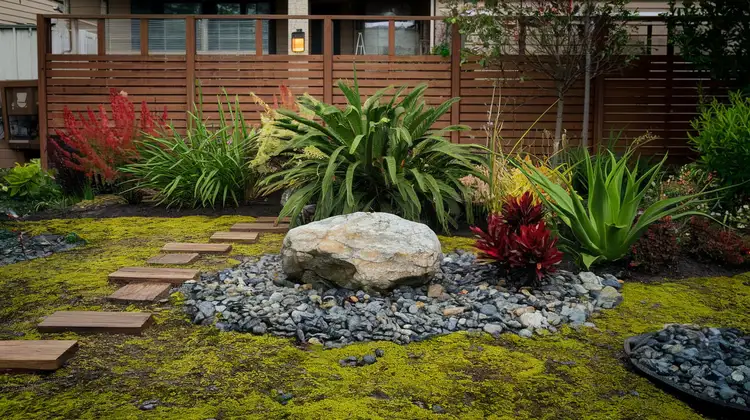
Water Conservation Strategies
Build your garden with plants that need little watering because they include succulents together with lavender and native perennials.
Drip irrigation systems should be used to distribute water directly to plant roots through efficient watering systems that reduce unnecessary waste.
Animals can collect rainwater through rain barrels, which serves as supplemental irrigation stock for minimizing residential water consumption.
Mulching for Soil Health
Organic mulch creates a hydration environment for the soil which minimizes water loss through evaporation.
Weed control improves through mulching because it stops weed development, which decreases herbicide usage.
The decomposition process of mulch transforms it into soil nutrients over time.
Pollinator-Friendly Planting
Native Flowers: Include a variety of butterfly-friendly flowers like coneflowers, daisies and milkweed.
Natural pest management solutions should be chosen as an alternative to chemicals, which safeguard pollinators.
A diverse plant selection enables biodiversity through planting multiple flowering species during different times of the year.
Permeable Hardscaping
Both gravel and permeable pavers serve to minimize runoff and enable ground infiltration of rainwater.
The use of grass pavers together with ground cover materials prevents soil compaction and helps in drainage processes.
Seasonal Care for a Front Yard Garden
A properly maintained front yard garden develops new seasonal attractiveness as it transforms from one season to the next. The landscape appears beautiful and remains healthy because of scheduled maintenance activities.
Spring Care
Clear away winter debris while trimming all damaged plants in the garden.
Poor soil quality can be corrected by adding organic fertilizers along with fresh compost.
Springtime is the right season for planting bulbs along with perennial plants to bring vibrant colors to your garden.
Understand irrigation systems by doing regular inspections of functionality.
Summer Maintenance
Early and late afternoon are the most suitable times for watering plants because it reduces fast loss of water through evaporation.
Except for flowering shrubs and dead blooms, all plants should receive proper pruning techniques to boost development.
Maintain continuous clearing of weeds and excessive plant growth in pathways and the lawn area.
Warm sun lovers should receive protective shade structures to protect them from harsh summer temperatures.
Autumn Preparation
Prevent overgrowth of leaves by collecting them for use as organic soil enhancers.
Plant fall-blooming flowers such as chrysanthemums and asters.
Planting mulch at the beginning of winter will help protect your plant roots.
To protect garden health during the season, it is helpful to divide and plant perennials.
Winter Protection
To protect valuable plants from freezing temperatures, cover them with burlap along with appropriate protective layers.
Diminish water supply as a means to stop root rot from affecting dormant plants.
Make all paths free of snowy conditions because it enables visitors to enter the area properly.
Create designs for new gardens and landscaping activities which will take place during the spring season.
Maximizing Small Front Yard Gardens
Every house lacks extensive front yards, but small spaces become beautiful landscapes when approached correctly.
Vertical Gardening
Plants should hang from walls through wall-mounted planters or trellises, alongside climbing plant designs to make the most of all available space.
Vertical landscape fences with jasmine vines and clematis creepers will create stunning natural front-of-house attractions.
Compact Planting Solutions
Select small dwarf plants and perennials since they will not spread beyond their intended size.
Plant arrangements in combination with raised beds or containers help use available space to the maximum.
Minimalist Hardscaping
Walking paths can be marked through the yard by placing stepping stones and pavers instead of using bulky objects.
Set up reflective items that let you see additional space throughout the environment.
Multi-Functional Features
The built-in storage feature of seating saves valuable real estate in a space.
The space will benefit from stackable and foldable furniture, which provides maximum flexibility.
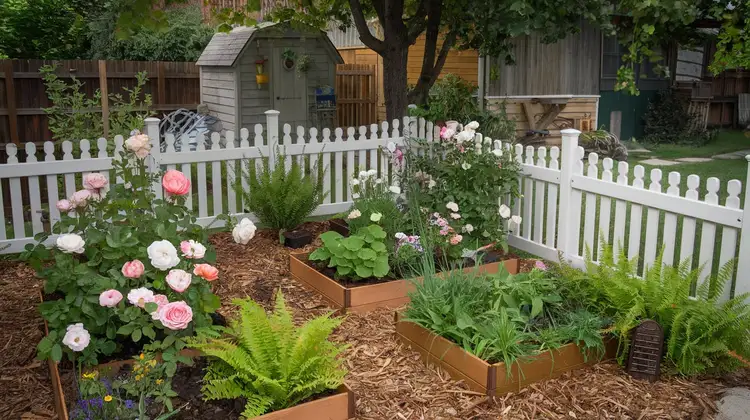
FAQs
I need to begin planning my front yard garden from the start?
You should start with selecting either a theme or style before choosing your plants and building paths, lighting elements and decorative aspects to integrate seamlessly.
Which plants should I choose for a low-care front yard design?
Your front yard plant selections of succulents alongside lavender, ornamental grasses and evergreens will need minimum care.
Which strategies would help me raise the attractiveness of my front yard entrance?
The addition of an organized pathway together with seasonal flowers under outdoor lighting and well-trimmed shrubs will produce an attractive exterior design.
Which plants work best for residential flower gardens located at the house entrance?
People commonly select roses, tulips, marigolds, hydrangeas and petunias to add colors that improve front garden aesthetics.

